You can eliminate household pests using simple vinegar-based solutions that are safe for your family and pets. Mix equal parts white vinegar and water with Dawn soap to disrupt ant trails, create apple cider vinegar traps for fruit flies, and add essential oils like peppermint for spider control. Use vinegar to clean surfaces and remove pest-attracting odors, apply it around windows and door frames as barriers, and combine it with baking soda for drain treatments that prevent breeding grounds. These proven methods will transform your pest control approach completely.
Vinegar and Dawn Soap Ant Deterrent
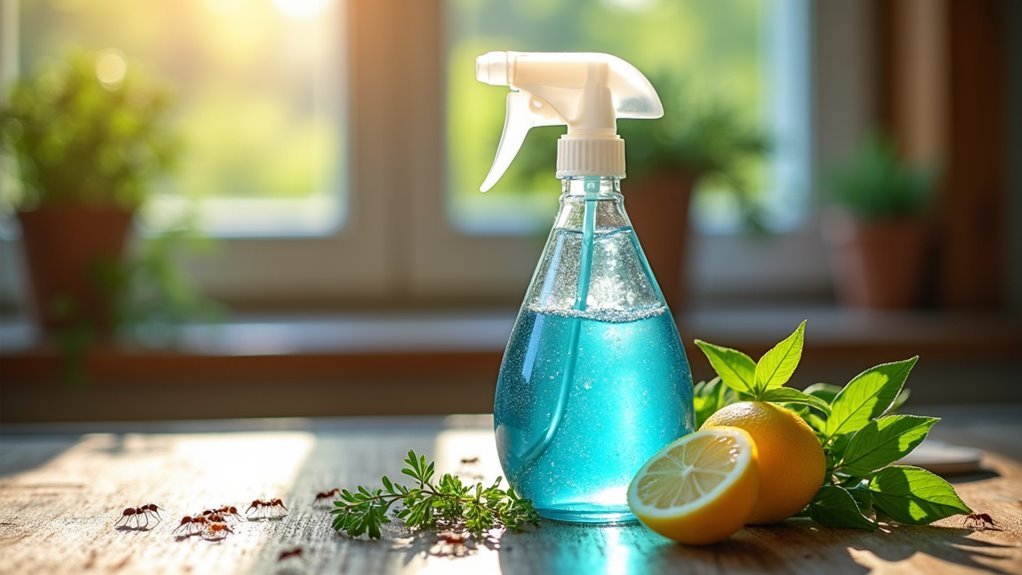
Ants marching across your kitchen counters don’t stand a chance against a simple vinegar and Dawn soap deterrent.
You’ll create this effective natural pest control by mixing equal parts white vinegar and water, then adding a few drops of Dawn dish soap.
The vinegar’s strong scent masks pheromone trails ants use for navigation, while the soap breaks down their exoskeletons and kills them on contact.
Apply this solution directly onto ant trails and entry points for maximum effectiveness.
The Dawn helps the mixture adhere to surfaces, providing longer-lasting protection.
This eco-friendly pest control for home offers a safe alternative to chemical products, making it perfect for households with children and pets.
Apple Cider Vinegar Fruit Fly Trap
You’ll find that fruit flies can’t resist the smell of apple cider vinegar, making it perfect bait for a homemade trap.
Setting up this simple solution involves creating a funnel effect that lets flies enter but prevents their escape.
The key to success lies in proper placement near problem areas and maintaining the trap’s effectiveness through regular monitoring.
Simple Trap Setup
Within minutes, you can assemble one of nature’s most effective fruit fly solutions using just apple cider vinegar and plastic wrap.
Pour a small amount of apple cider vinegar into a shallow bowl, ensuring there’s enough liquid to attract the pests.
Cover the bowl tightly with plastic wrap, creating a secure barrier that prevents escape routes.
Use a toothpick or needle to punch several small holes through the plastic wrap – these entry points should be large enough for fruit flies to enter but small enough to trap them inside.
The vinegar’s fermented scent acts as an irresistible lure, drawing flies into your homemade trap.
This eco-friendly solution eliminates the need for harsh chemical sprays while effectively reducing fruit fly populations.
How It Works
Understanding the science behind this trap reveals why apple cider vinegar proves so effective against fruit flies. The vinegar’s fermented properties mimic the scent of rotting fruit, which naturally attracts these pests.
When you add liquid dish soap, it breaks the surface tension of the vinegar, causing fruit flies to sink and drown rather than simply landing on the surface.
The plastic wrap covering creates a one-way entry system. You’ll leave one edge slightly lifted, allowing pests to enter while making escape nearly impossible.
Once inside, fruit flies become disoriented and can’t locate the small opening again. This combination of attractive bait and strategic entrapment makes the method incredibly effective for eliminating fruit fly infestations without using harsh chemicals.
Placement and Timing
Strategic placement determines whether your apple cider vinegar trap succeeds or fails in eliminating fruit flies. Proper positioning and timing will keep these pests away effectively.
Follow these placement guidelines for ideal results:
- Active zones: Position traps near kitchens, dining areas, or wherever you’ve spotted fruit fly activity.
- Warm, bright locations: Place traps in well-lit areas with natural warmth, as fruit flies gravitate toward these conditions.
- Multiple trap placement: Set several traps throughout affected areas to maximize coverage.
- Maintenance schedule: Replace the vinegar solution every few days to maintain its attractiveness.
You’ll notice the trap’s effectiveness diminishes over time as the vinegar’s smell weakens.
Consistent placement in high-traffic fruit fly zones, combined with regular replacement, guarantees continuous pest control without harsh chemicals.
White Vinegar Surface Cleaning for Pest Prevention
You’ll find white vinegar’s acidic properties naturally disrupt ant trails and eliminate the odors that attract pests to your home.
Focus your cleaning efforts on countertops, baseboards, and entry points where you’ll apply a simple mixture of equal parts vinegar and water.
Target kitchen surfaces, doorways, and windowsills where insects typically enter and leave pheromone trails that guide other pests to food sources.
Vinegar’s Natural Pest Properties
When you’re looking for a powerful yet gentle cleaning solution that doubles as pest control, white vinegar emerges as one of nature’s most effective options.
This environmentally friendly solution disrupts ant communication systems and eliminates pheromone trails that guide pests back to your home.
White vinegar’s acetic acid content provides four key pest-fighting benefits:
- Trail Disruption – Breaks down chemical pathways ants use for navigation
- Pheromone Elimination – Removes scent markers that attract returning pests
- Natural Deterrent – Creates an inhospitable environment for various insects
- Food Source Removal – Cleans residues that draw pests to surfaces
You’ll find that regular use of white vinegar maintains a pest-free environment while avoiding toxic chemicals, making it safe for families and pets.
Effective Surface Cleaning Techniques
Now that you understand vinegar’s pest-fighting properties, proper application techniques maximize its effectiveness across different surfaces.
Mix 1/4 cup white vinegar with 2 cups water to create your pest-deterrent cleaning solution for home use. Focus on kitchen counters, dining tables, and areas where food spills occur, as the acidity neutralizes residue that attracts pests.
Wipe down pet feeding zones and water bowls regularly to eliminate scent remnants that draw ants and cockroaches. These effective surface cleaning techniques disrupt ant communication trails while disinfecting surfaces simultaneously.
Clean spills immediately and maintain weekly cleaning schedules in high-traffic areas. The natural antibacterial properties eliminate odors and bacteria, creating an inhospitable environment for common household pests.
Target Areas and Application
Since ants follow chemical trails to locate food sources, applying your vinegar solution directly along their pathways disrupts their navigation system most effectively.
Focus on these critical target areas where pests commonly establish routes:
- Kitchen surfaces – Spray countertops, cabinet edges, and appliance bases where food residues accumulate.
- Entry points – Treat door frames, window sills, and crack edges where ants typically enter your home.
- Dining areas – Clean table surfaces, chair legs, and floor perimeters after meals.
- Baseboards and corners – Apply solution along wall-floor junctions where ants often travel.
You’ll want to reapply the vinegar mixture every few days for maximum effectiveness.
The acidic properties eliminate scent trails while creating an inhospitable environment that deters future infestations.
Essential Oil and Vinegar Spider Repellent
Although commercial spider sprays promise quick results, essential oils and vinegar offer a safer, natural alternative that’s equally effective at keeping these eight-legged visitors out of your home.
You can create a powerful repellent by mixing equal parts water and white vinegar in a spray bottle, then adding a few drops of peppermint, eucalyptus, or tea tree oil. These essential oils produce strong scents that spiders find unbearable, while vinegar disrupts their pathways.
Apply this mixture regularly to entry points, corners, and areas where you’ve noticed webs. You’ll not only repel spiders but also enjoy pleasant aromas throughout your space.
This non-toxic approach protects your pets and children while maintaining an effective spider-free environment.
Vinegar-Based Cockroach Deterrent Spray
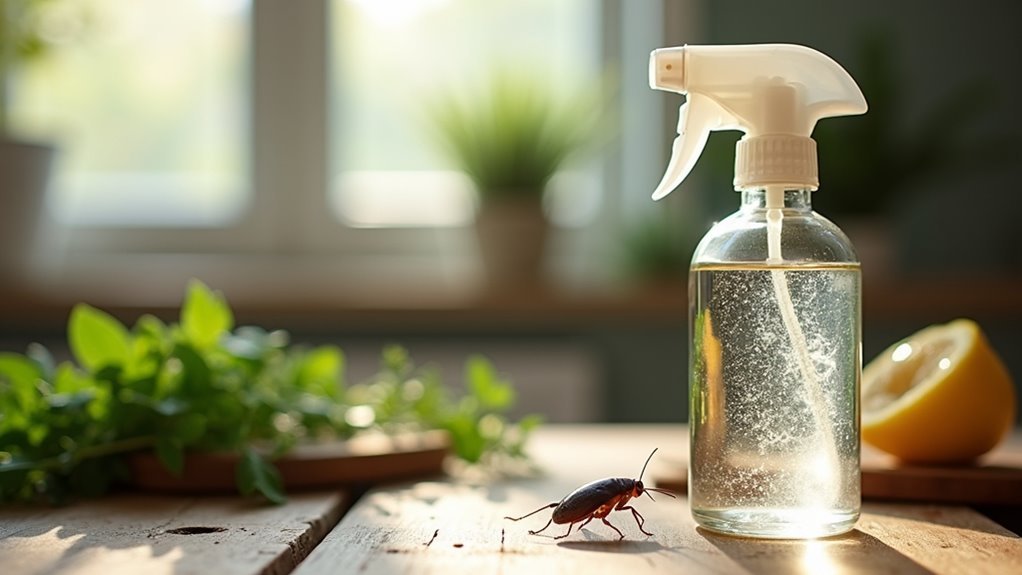
Cockroaches rank among the most persistent household pests, but a simple vinegar-based spray can effectively disrupt their invasion without exposing your family to harsh chemicals.
This vinegar-based cockroach deterrent spray combines equal parts white vinegar and water, creating a powerful solution that disrupts scent trails while cleaning surfaces of potential food sources.
To maximize effectiveness, follow these steps:
- Add peppermint or eucalyptus essential oils to enhance repelling properties.
- Target common entry points like cracks, crevices, and areas near garbage bins.
- Apply thoroughly in locations where you’ve spotted cockroach activity.
- Reapply weekly to maintain consistent protection.
The acetic acid in vinegar naturally repels these pests without harmful chemicals, making it safe for homes with children and pets.
Herb-Infused Vinegar for Multi-Pest Control
You can enhance vinegar’s pest-fighting power by infusing it with aromatic herbs that naturally repel insects.
This upgraded solution targets multiple pests simultaneously while creating a pleasant scent that won’t overwhelm your living space.
The combination of vinegar’s acetic acid and herbs’ natural oils creates a potent yet safe barrier that disrupts pest behavior patterns.
Creating Herb-Infused Solutions
When you’re seeking a versatile, chemical-free solution for multiple pest problems, herb-infused vinegar offers an effective approach that combines the natural repelling properties of aromatic herbs with vinegar’s proven pest-deterrent qualities.
Creating your own pest-repelling solution requires just fresh herbs and white vinegar:
- Select your herbs – Choose rosemary, basil, or mint based on target pests.
- Steep the mixture – Submerge herbs in white vinegar for 1-2 weeks.
- Strain and transfer – Remove plant matter and pour into spray bottles.
- Apply strategically – Target entry points, surfaces, and pest-prone areas.
This herb-infused vinegar effectively deters ants, spiders, and fruit flies while doubling as a natural cleaner.
You’ll maintain a fresh, pest-free environment that’s safe around pets and children.
Application and Effectiveness
While many commercial pest control products require repeated applications and pose health risks, herb-infused vinegar delivers immediate results with a single strategic spray.
You’ll see ants abandon their trails within hours as the acetic acid disrupts their navigation system. Apply this natural pest repellent directly to entry points, windowsills, and areas where you’ve spotted insect activity.
For maximum effectiveness, spray the solution weekly around baseboards and door frames.
You’ll notice that this herb-infused vinegar simultaneously cleans surfaces while deterring various pests. The rosemary and sage compounds create an invisible barrier that insects avoid instinctively.
Unlike harsh chemicals, you can safely use this solution around your family and pets without ventilation concerns or protective equipment.
Vinegar and Baking Soda Drain Treatment
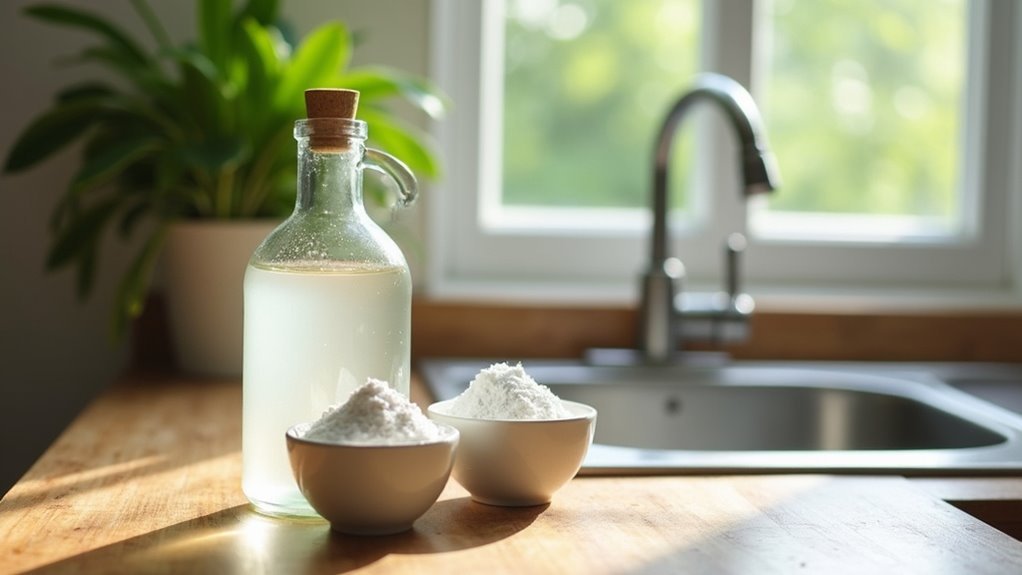
Since fruit flies and drain flies thrive in the organic buildup that accumulates in your kitchen and bathroom drains, targeting these breeding grounds becomes essential for effective pest control.
Eliminating organic debris from drains disrupts the lifecycle of fruit flies and drain flies at their primary breeding sites.
You can create a powerful natural drain cleaner using vinegar and baking soda that eliminates clogs and odors without harsh chemicals.
Follow these steps for effective drain treatment:
- Pour 1 cup of baking soda down the drain
- Follow immediately with 1 cup of vinegar
- Let the mixture sit for 30 minutes
- Flush thoroughly with hot water
The chemical reaction produces carbon dioxide that dislodges debris and grime where pests breed.
This family and pet-friendly method keeps your drains clear and odor-free, preventing future pest infestations when applied regularly.
Window and Door Frame Vinegar Barrier
Although ants can enter your home through the smallest cracks and crevices, you can create an effective natural barrier using a simple vinegar solution around your windows and door frames. Mix equal parts white vinegar and water in a spray bottle, then apply this vinegar barrier around entry points. The strong scent disrupts ant pheromone trails, stopping pests from getting inside and locating food sources.
| Application Area | Frequency |
|---|---|
| Window frames | Weekly |
| Door frames | Weekly |
| After rain | Immediately |
| After cleaning | As needed |
This non-toxic solution won’t harm pets or children while doubling as a natural cleaner. Reapply regularly to maintain effectiveness against unwanted visitors.
Vinegar-Soaked Cotton Ball Placement Method
- Prepare the solution – Mix equal parts white vinegar and water
- Soak thoroughly – Saturate cotton balls in the vinegar mixture
- Place strategically – Position near entry points, windowsills, and active ant trails
- Replace regularly – Change cotton balls every few days to maintain potency
The strong vinegar scent makes it difficult for ants to locate food sources and return to their nests.
You’ll appreciate this safe alternative around pets and children while effectively controlling indoor pest problems.
Cleaning Vinegar for Pet-Safe Flea Control
When fleas invade your home, cleaning vinegar offers a powerful yet pet-safe solution that disrupts their entire life cycle without exposing your furry friends to harsh chemicals.
This natural acetic acid solution effectively eliminates flea eggs and larvae when you use it in your floor and carpet cleaning routine.
Create an equal-parts mixture of water and white vinegar to spray on pet bedding and areas where your pets frequently roam. The strong scent acts as a natural repellent while killing existing fleas.
Before applying your cleaning vinegar solution, thoroughly vacuum carpets and upholstery to remove adult fleas and debris.
Always let the vinegar solution dry completely after application to prevent slippery surfaces in pet areas.
This pet-safe flea control method maintains a chemical-free environment.
Frequently Asked Questions
How Do I Keep Bugs Out of My House Without Pesticides?
Clean regularly and seal cracks in walls, windows, and doors. You’ll block entry points effectively. Spray essential oils like peppermint around your home, and sprinkle food-grade diatomaceous earth where you’ve seen insects.
What Is the Best Natural Pest Repellent?
You’ll find essential oils like peppermint and eucalyptus work exceptionally well as natural pest repellents. They’re safe around family and pets while effectively deterring insects without harsh chemicals or toxins.
How Do I Get Rid of Bugs in My House Without Harming Pets?
You can use food-grade diatomaceous earth in carpets, vinegar-water sprays on surfaces, essential oil repellents, and DIY fruit fly traps. These natural solutions eliminate pests effectively while keeping your pets safe.
What Is the Best Homemade Bug Spray for a House?
You’ll get excellent results mixing equal parts water and vinegar for general pest control. For stronger action, combine one cup rubbing alcohol with two cups water to immobilize bugs on contact.
In Summary
You’ve now got nine powerful, chemical-free solutions to tackle indoor pests naturally. These vinegar-based remedies won’t harm your family, pets, or the environment while effectively deterring ants, flies, spiders, cockroaches, and fleas. Start with the methods that target your specific pest problems, and don’t hesitate to combine treatments for stubborn infestations. With consistent application, you’ll maintain a pest-free home using simple ingredients you likely already have in your kitchen.

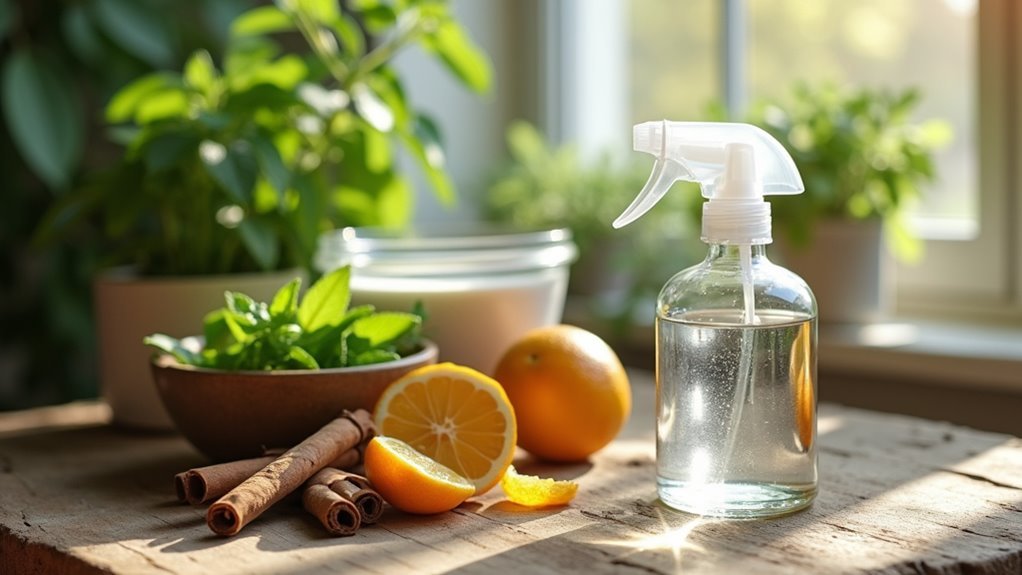
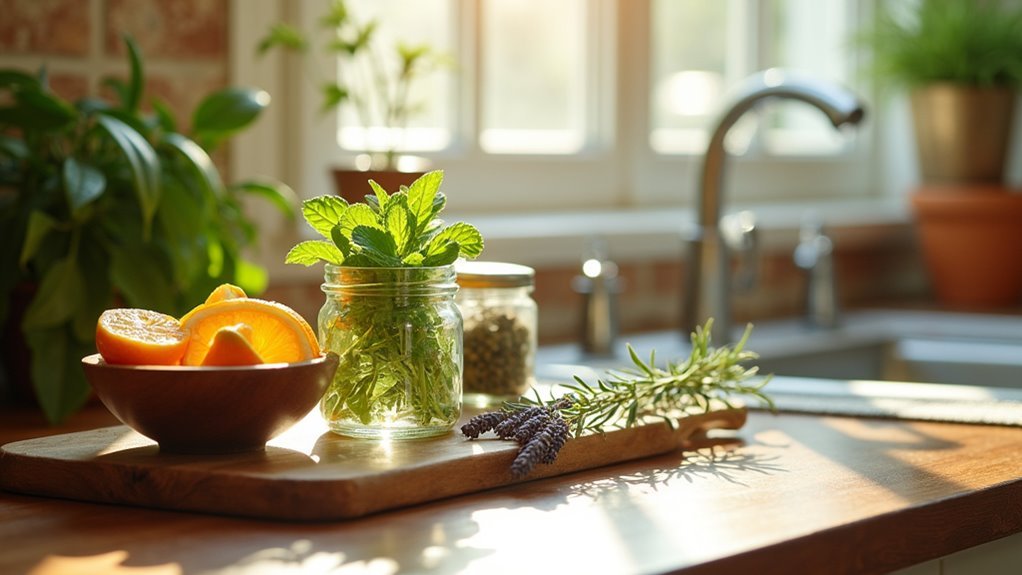
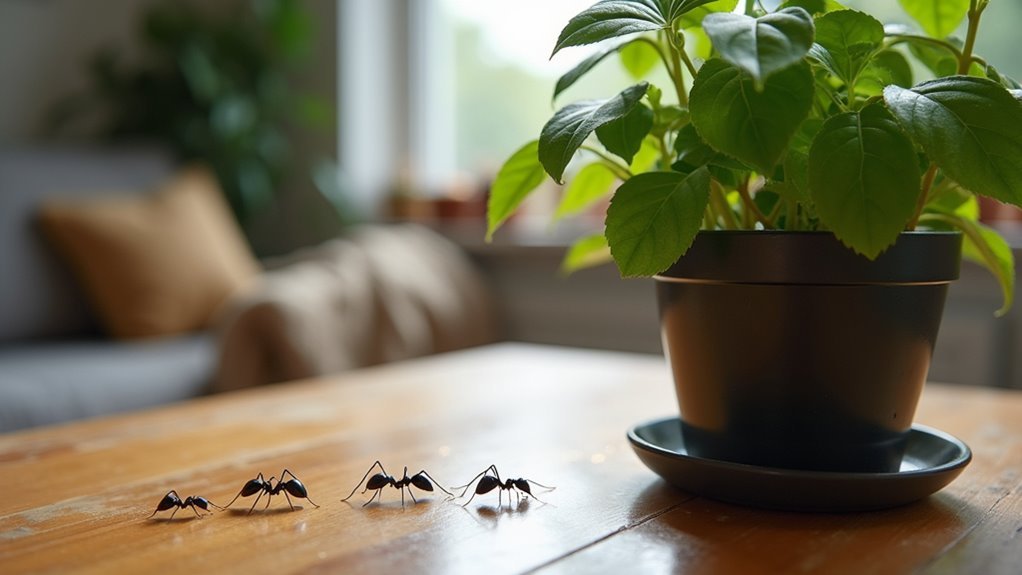
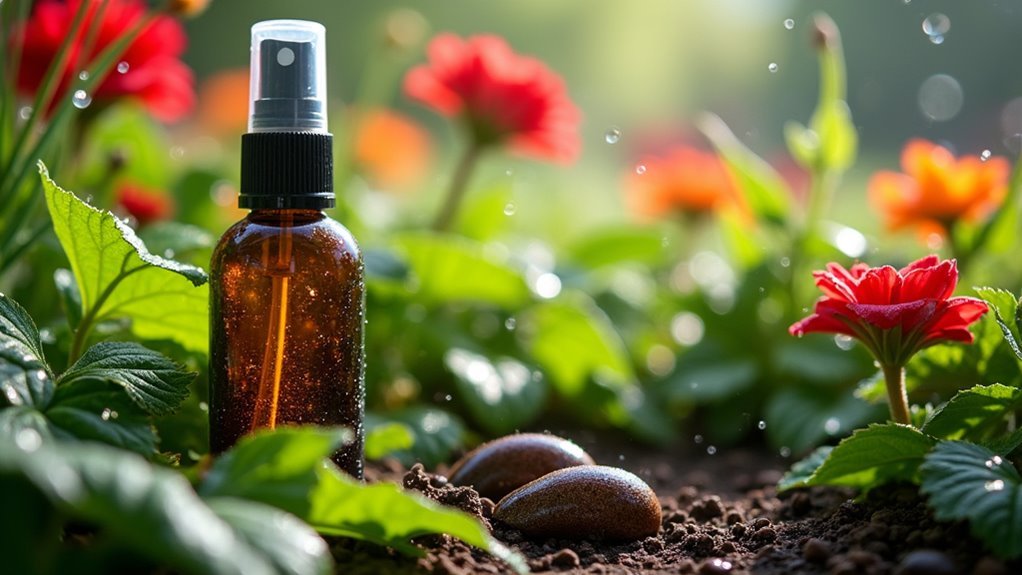
Leave a Reply